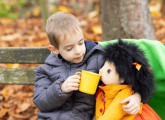NDNA’s director of quality and workforce development, Stella Ziolkowski, offers advice on responding to disruptive children’s troublesome traits…
Q: How should I deal with children biting?
A: While upsetting for those on the receiving end, biting is a common stage of children’s development. To support this appropriately, try to find out why the child is resorting to biting. In many cases it’s because they are frustrated and cannot find any other way to express themselves. If it was through frustration, was this because they have trouble sharing? (See below for tips on how to deal with this.)
It’s useful to talk to the child’s parents to see if there may be any underlying reason as to why the child has started biting and to ensure the same messages about biting are being reinforced at home to try and resolve the situation quickly.
You can also help by looking at the environment in your setting, including the layout of the room, the toys available and how the sessions are structured. Is there enough to engage the children? If not, look at ways you could improve this.
Q: A child in my setting has started being very aggressive with her peers, including kicking and hitting. What steps should I take to try to resolve this issue?
A: Again, start by arranging a meeting with the child’s parents to inform them of what has happened, to try to identify possible causes for this behaviour. Have there been any changes at home? Are there any underlying medical issues?
A good idea is to map the child’s behaviour, noting what was happening before the incident (e.g. what time of day it was or what the child was doing), during the incident (e.g. how did you deal with it?) and afterwards (e.g. did the child respond to the support given?). This should help you spot the behaviour in future and stop it before it starts.
It’s crucial that all the children in your setting are kept safe at all times, so if several incidents occur you may need to think about how the child in question is being supervised and whether additional support is needed.
It’s a good idea to have a behaviour policy in place that sets out clearly the behaviour expected from children and how you will support children and families. This can be shared with parents so they are aware of what you expect, and what they can do to help. If you are revising your policy, encourage staff to share their opinions and children to talk through their ideas for positive behaviour, as well as talking to parents to find out their views. A sample behaviour management policy is available free to NDNA members.
Q: One three-year-old in my setting becomes upset if other children play with his favourite toys or if staff give attention to another child. How can I encourage him to share?
A: As with biting or aggressive behaviour, a consistent approach at home and in the nursery is important in supporting the child and helping them to learn more positive behaviour. Speak to the child’s parents initially and find out if this behaviour also happens at home, and if so, how they deal with it.
Many children find it difficult to share, so it’s a good idea to talk about it to all the children in your setting, as age appropriate, so no one feels singled out. This is also an opportunity for positive reinforcement, with a marble jar, stickers or ticks on a chart for all children to receive if they share with others.
NDNA is the national charity and membership association for children’s nurseries across the UK, supporting settings across all sectors to deliver the best possible care and early learning for children whilst ensuring they are sustainable businesses.

Empathy dolls – Use them to explore big emotions
Editors picks
